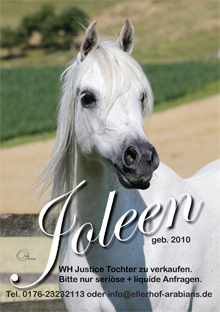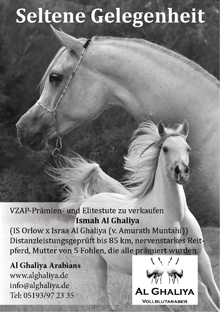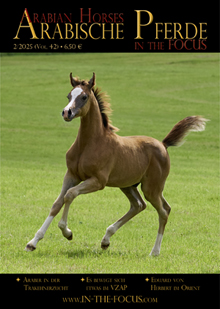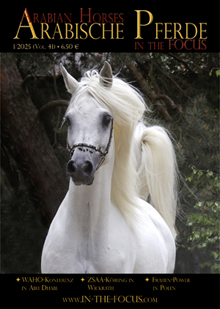During the season 2016/2017, twelve horses died in the United Arab Emirates during endurance competitions. This must come to an end!

After all the bad news we reported in our last issues, I was desperate to write something positive about endurance, because it is a wonderful sport that suits the horse, if done correctly and with horsemanship. But once again, the current events in the UAE have ruined it all.
Death on the first loop
Since the Middle East season started in October 2016 no less than twelve horses have died in endurance competitions. Eight of them died on Loop 1!
At the CEN 100 km HH Sh. Mohammed bin Rashid Al Maktoum Endurance Ride for Ladies on 4th January, the “Al Nasr – 2 Endurance Stable” had 19 horses entered, and all were eliminated: two of the horses died, four were eliminated for irregular gate, one for metabolic reasons, two were “out of time” and ten were retired by their riders. This can hardly be explained with “tragic accidents”. A FEI spokesman said after the eighth casulty: “The FEI is extremely concerned that there have been a number of in-competition endurance fatalities in the UAE this season… The catastrophic injuries that have occurred this season have all been in the first loop, so it suggests that these are pre-existing fractures and that there is a serious issue with training techniques…” Also FEI Endurance director Manuel Bandeira de Mello said: “The two latest equine fatalities during a national event (CEN) at DIEC on 23 January are very worrying, and there is an urgent need to understand from a veterinary and scientific perspective what is causing these catastrophic injuries… It’s clear that over-training is probably the major cause and respect of rest periods is also crucial.”
While aiming to find out the underlying causes for the CIs (Catastrophic Injuries), the FEI also emphasises on rules and education, staging seminars for riders, trainers, owners and veterinarians. But will the information really reach those who need it? As long as the education program only includes seminars, but no tests, which you can pass or fail with the corresponding consequences, not much will be achieved.
The report of an affected Belgian rider gives some insight into the underlying causes of these “accidents”: “Last Thursday, a team that is not the one I work for, asked me to ride Sharif on the private race [race for private owners]. The goal was just to finish. At the first loop on an average speed of 22km / h, at kilometer 39, Shareef stumbled by accident and fell on me. A fracture of the front leg is diagnosed…” From this report we can conclude the following: The rider did not know the horse, did not train it herself, and did not know if it got any medication. A responsible rider would not do this. Apart from that, the horse was only registered four days prior to the ride for his new owner with the FEI.
Three Endruance Centers in the UAE
There are three Endurance Centers in the UAE, the DIEC (Dubai International Endurance City) of Sheikh Mohammed Al Maktoum in Dubai, the Al Wathba Endurance Village of Sheikh Manoor Bin Zayed Al Nahyan in Abu Dhabi, and Bouthieb of Sheikh Sultan bin Zayed Al Nayan in Abu Dhabi. By far the most CI’s happened at the DIEC, where in total most of the rides are being held (in the 2016 / 2017 season, 31 rides took place at the DIEC, 20 at Al Wathba, 12 at Bouthieb). At Bouthieb, for the second season now, the rides are organised according to the “Bouthieb Rules”, which includes a “speed limit”, more strict recovery indices, and (new) natural trails (see more about this page xx); since then, there were no CI’s anymore in Bouthieb.
Endurance associations write to FEI
Several endurance organisations in Europe (Great Britain, Switzerland, Norway, Sweden and Denmark) have banned their riders, to ride in the UAE; Belgium suggest it to their riders. Also the Board of the German Equestrian Olympic Committee (DOKR) has decided, that until further notice, no German rider will get permission to start at international endurance rides in Dubai. Should any German rider participate at a national ride in Dubia, the DOKR reserves the right to no longer consider their nominations for future championships or Federal Cadres. Apart from that, the Board asks the organisers of endurance rides in Germany not to invite any riders from the UAE anymore. These decisions are fully supported by the German Endurance Riders Association (VDD).
Also USA and Australia have reacted to these incidents. The American Endurance Ride Conference (AERC) Michael Campell, requests in his letter “that the Dubai endurance community being suspended indefinitely from all endurance competitions until FEI is able to determine that the causes of these fatalities have been discovered and remedied by the endurance community in Dubai.” He further states that “these continued failures give all equine enthusiasts, and particularly endurance riders, an extremely poor public image…”
Obviously, such a ban is quite (financially) painful for these international (foreign) riders, who are no longer allowed to start in Dubai. But they should be aware that by participating in such rides, they are keeping the wheel turning and with it, they are partly responsible for what is discrediting the whole endurance sport – no matter how good (in the sense of horsemanship) they are riding or not. It has become a useful tactic to invite the foreign riders – including their horses – to the H.H. Sh. Mohammed Bin Rashid Al Maktoum Endurance Cup, a 160 km ride with prize money of 8.8 Mio AED (2.25 Mio €). Among the TOP TEN, the amount of 4.7 Mio AED is divided (i.e. 47.000 € each), all those who successfully complete the ride on place 11+ will get 25.000 € each. This year, the beneficiaries of these Pennies From Heaven were (among others) 15 riders from 12 different European countries. But that’s not enough, three of the European horses booked a one-way-ticket and were sold in the UAE to the M7 stables, among them Sharouk, a 10-year-old Partbred gelding by Normativ ox, successfully ridden to place 51 in the said ride. “M7 is an Elite stable in Dubai and it is a great honour to sell a horse to them”, stated the ex-owner in a Facebook post.
Invitation with ulterior motives
It is clear, that the purpose of these invitations is manifold: First, the UAE can demonstrate: “Look at all these successful riders from abroad which are coming to us, they are supporting us in our goals!” Secondly, hardly any of those invited will dare to speak badly about the event, no matter how many horses die, because they want to be invited again. Thirdly, with the option of 25.000 € prize money by completing the ride, they will not ride fast enough to interfere with the top. Fourthly, the best horses can be bought by UAE stables. A win-win-scenario. Except, for the horses, they are the losers.
To dry the swamp
But the swamp is even deeper: Among those, who profit by selling horses to the UAE are also officials of some of the national Endurance Riding Associations. So, it does not come as a surprise that certain countries remain quiet and don’t push the FEI for stricter rules.
Quite clearly, anybody selling his horse to any Dubai stable, is guilty as well by keeping the wheel turning. Of the 80 horses, that have successfully completed the said 160 km ride, all were bought abroad: France sold 25, South Africa 14, Australia 9, Uruguay 6, and Argentina, Botswana, Czech Republic, Spain, Great Britain, Germany, Italy, Namibia, New Zealand, Poland, Portugal, Russia, Slovakia, Sweden, Tunisia, and the USA 1 to 3 each. It is quite big business, even if the prices for individual horses aren’t astronomical, it is the sheer numbers that counts. And let’s face it: For any horse that dies, or that can no longer compete, they need replacement, as the UAE does not breed (many of) their endurance horses themselves. So, who of these selling countries is interested to cut off the branch on which they are sitting?
The bad image of Endurance riding
Undoubtedly, there are many endurance rider who are appalled by what is going on in the Middle East – but what can they do? First, ask your endurance association to write a letter. This has happended already in many countries. One may argue, that a letter may not help much, but it is an declaration of intend which is needed to show the public, that you don’t agree with what is going on and it will put more pressure on FEI to hurry up with a lasting solution. Secondly, your endurance association/Natonal Equestrian Federation can also decide not to allow their riders to go to Dubai, as they are being misused as promotion of a wrong cause. And thirdly, if you are concerned about the welfare of your horses, don’t sell any horse to Dubai (or most of the other places in the Middle East).
However, last but not least, it is up to the FEI to finally react resolutely. Where somebody’s ego demands to be recognized by the world as “the number one of endurance riding”, the exclusion from participating in the big Championships and other international rides can work miracles. Also, the “endurance world” would send a clear message, that these wheelings and dealings have nothing to do with their sport. This may not help any horse immediately, and they will continue to die on the tracks of endurance rides in Dubai. And it should not let anybody forget about the matter, to the contrary: Each individual case needs to be picked out and published. But a participation ban for the World Championships and other international rides outside the UAE would hurt. And if our endurance ride organisers complain, that the sponsoring from Arab countries is missing, then this is the price we all have to pay to make an end to these problems.
This may sound naive, but it is better than putting your hands in your lap, pushing the responsibility to somebody else, and waiting for the next horse to die. At least we must have tried to change something.
Gudrun Waiditschka
AP-1-17-Distanzsport-UAE.pdf (3834 downloads ) |














